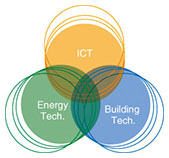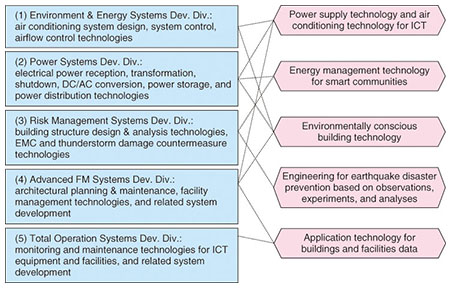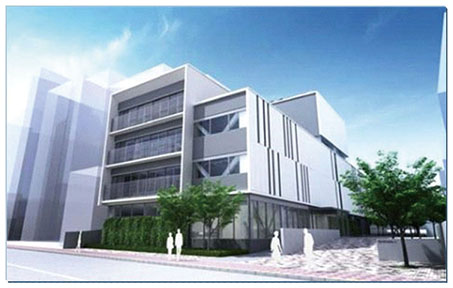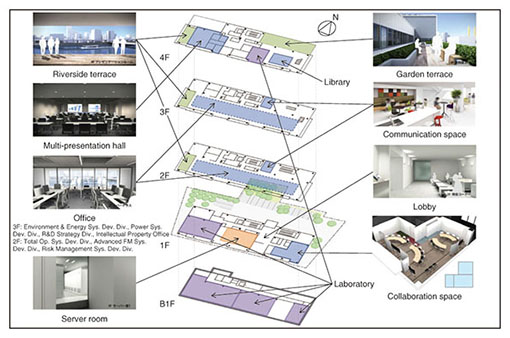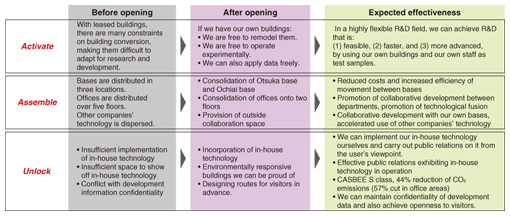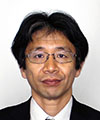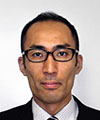 |
|||||||||||
|
|
|||||||||||
|
Feature Articles: R&D Efforts at NTT FACILITIES Vol. 12, No. 11, pp. 51–58, Nov. 2014. https://doi.org/10.53829/ntr201411fa9 Approaches to Technological Fusion of “ICT × Energy × Building” and New R&D BasesAbstractNTT FACILITIES has had a research and development (R&D) framework ever since it was established, and we have honed our fusion technology by crossing information and communication technology with energy technology and building technology. We give an overview in this article of our R&D activities and describe the opening of our new R&D base in July 2014. We also explain our objectives in relocating our R&D Headquarters and our efforts underway toward fusing the above technologies at our new base. Keywords: research and development, technological fusion, NTT FACILITIES Shin-Ohashi Building 1. IntroductionNTT FACILITIES was spun off from NTT in December 1992 and celebrated its 21st anniversary as an independent company at the end of 2013. We have been proactively implementing design and maintenance of power supply systems and building construction projects for the NTT Group, while also expanding the provision of services to the open market by making use of the technologies that have been continually improved over a long period, including when we were with the Nippon Telegraph and Telephone Public Corporation and NTT. We have recently been providing integrated facility services based on consideration of the global environment in all phases from planning, through design and construction, to operation, with the slogan “Smart & Safety®.” For example, in datacenter-related business operations, we have applied our know-how in the design, construction, and maintenance of large numbers of communication buildings; in fact, we have been involved in constructing 30% of the datacenters in Japan, covering 240,000 m2 of space. We have also simultaneously expanded our business operations that involve the maintenance of overseas datacenters. We have also contributed to the mega-solar construction business in response to recent increases in the demand for renewable energy. Since the start of the Feed-in Tariff scheme in 2012, we have constructed solar power generation systems totaling over 400 MW at 200 locations all over Japan, and we also own and run solar power generation plants at 50 locations that produce a total of 150 MW of power. From the start of its foundation, this company has had a research and development (R&D) structure, and we have honed our strengths in information and communication technology (ICT), energy technology, and building technology to realize the “ICT × Energy × Building” fusion (Fig. 1). The mission of our R&D Headquarters is to create technology that differentiates us from other companies and that serves as a source of our competitive strength.
2. Locations and organization of NTT FACILITIES R&D HeadquartersUp until now, our R&D facilities were based at three locations: the G.H.Y. Building (offices) in Toshima-ku, Tokyo, the NTT Musashino Research and Development Center (laboratories) in Musashino City, Tokyo, and the main NTT Ochiai Building (laboratories) in Toshima-ku, Tokyo. We have now created a two-base structure by constructing the NTT FACILITIES Shin-Ohashi Building in Koto-ku, Tokyo, which brings together the functions of the G.H.Y. Building and the NTT Ochiai Building. The Shin-Ohashi Building contains offices, laboratories for conducting tests on power supply systems aimed at datacenters, testing facilities for verifying our wide-area monitoring system, and shielded rooms for conducting tests related to electromagnetic compatibility (EMC), among other things. At the NTT Musashino Research and Development Center, we continue to make use of facilities such as a three-dimensional (3D) vibration table used for replicating earthquakes and testing the earthquake-resistance of the structural components of buildings and ICT equipment, a simulated datacenter facility for conducting full-size experiments on datacenter air conditioning systems, artificial climate chambers capable of implementing tests on air conditioning units in environments ranging from –10ºC to 50ºC regardless of the climate outside, and temperature-controlled rooms for performing accelerated life testing of storage batteries over long periods. The R&D Headquarters consists of seven departments (Fig. 2). The R&D Strategy Division and the Intellectual Property Office are indirect departments, with the former being responsible for areas such as planning, general affairs, and financial matters of the headquarters, and the latter being responsible for intellectual property management and export control for the NTT FACILITIES Group. The remaining five departments are primarily involved in various R&D activities. We introduce here the fields and strengths of these five departments.
2.1 Environment & Energy Systems Development DivisionThis division is staffed by air conditioning engineers and monitoring and control engineers, who mainly develop air conditioning units for ICT equipment, integrated control technology for cold water-use refrigerating systems, airflow control technology for datacenter rooms, and technology for the air conditioning systems of datacenters. To date, a cumulative total of more than 50,000 units of the FMACS®-V series and FTASCL® series systems, which are packaged air conditioning units designed for datacenters, have been delivered. These systems make it possible to achieve high energy efficiency throughout the year. NTT FACILITIES has been the first in the industry to develop and bring to market cold aisle containment technology, which is intended to save energy by inhibiting the mixing of supplied cold air and emitted warm air within the datacenter room. 2.2 Power Systems Development DivisionThe staff of this division consists of electrical power engineers whose area of expertise is primarily power feed technology that focuses on reliability. They develop technology related to power reception, power transformation, shutdown, DC/AC (direct current/alternating current) conversion, power storage, and power distribution for ICT equipment. Their high-voltage direct current (HVDC) power supply system implements higher levels of reliability and power feed efficiency than ordinary AC power systems. Their bidirectional interruption-free switching technology is applied to equipment for supply-and-demand management that freely switches electrical power from various sources, including power generated by solar power systems and power stored in batteries. This division has also developed and marketed a large flame-retardant lithium-ion battery that is suitable for backup use. Additionally, they are working on R&D of design, construction, diagnosis, and maintenance technology for renewable energy systems such as solar power generation. They are engaged in the evaluation of solar power generation panels from various vendors, the development of design support tools for in-house use, and the development of malfunction and deterioration diagnosis technology. 2.3 Risk Management Systems Development DivisionThe engineers in this division specialize in the areas of building structures and the development of countermeasures against EMC problems and thunderstorm damage. The ICT buildings that form our social infrastructure are of course required to have sufficient earthquake resistance. However, as they are often connected to steel towers, much effort has been put into the R&D of building structural engineering. This division’s unique earthquake observation network, 3D vibration testing facilities, and structure simulation program that was developed in-house provides an edge in the area of building structural engineering. After the Great East Japan Earthquake, there were reports of incidents involving the collapse of air conditioning units suspended from the ceilings of office buildings in the Kanto region around Tokyo, which is some distance from the earthquake center, so the engineers in this division clarified the mechanism of the occurrence through replication experiments using 3D vibration testing equipment. The expertise obtained was immediately reflected in building design. The building structural engineers are also developing inexpensive frames for solar panels that are easily constructed and highly durable. EMC and thunderstorm damage countermeasure technology that was primarily intended to protect ICT equipment is now not limited to ICT-related applications only; there is increasing demand for this technology in various fields such as those related to solar power generation and broadcasting. This division provides a consulting service and also applies the knowledge gained to develop countermeasure hardware, design methods, and design tools. 2.4 Advanced FM (Facility Management) Systems Development DivisionThis division is made up of engineers specializing in the areas of architectural planning and maintenance, facility management, and system development. Because NTT FACILITIES has been responsible for the planning, design, and maintenance of the substantial number of buildings of the NTT Group, this division has accumulated a great deal of experience in fields such as overall design techniques, design and construction technology specializing in ICT infrastructure buildings, environmentally friendly green building design technology, and office design technology that fosters high intellectual productivity. In addition, in FM practices today, it is necessary to collect information on all facilities owned by a company, make full use of ICT to perform quantitative analyses, and reflect the results in maintenance activities based on sound business judgment. For that reason, this division is developing technology and systems related to checking, measuring, information management, and analysis of buildings, and developing building management systems and entrance/exit management systems that effectively use ICT. 2.5 Total Operation Systems Development DivisionThe engineers in this division handle the monitoring and maintenance of ICT equipment and facilities, and also the development of related systems. The two bases in Japan perform round-the-clock monitoring of the 20,000 buildings and 200,000 units of ICT equipment of the NTT Group, and this division is in charge of developing facilities for these monitoring activities. Maintenance staff members are also stationed throughout Japan, and this division is also developing technology for supporting them. 3. Technological fusion of “ICT × Energy × Building”Up until now, this company has accumulated many kinds of technology from diverse fields and provided it in services and products to our customers. For example, datacenter construction requires technological elements of all five departments described above. However, the demands of customers have been rising recently, and there is also a need to reinforce our competitive strengths, so it has become necessary to apply a fusion of technology not only at the products and services level, but also at the level of technology itself. We describe here an overview of the technological fusion areas introduced in these Feature Articles (Fig. 3).
3.1 Power supply technology and air conditioning technology for ICT [1]There is a strong demand for energy conservation in ICT buildings, especially datacenters, because in addition to the energy consumed by the ICT equipment itself, the power supply and air conditioning equipment also consume a significant amount of energy. In the past, we have sought out energy-conservation technology for power supplies and for air conditioning equipment. However, we are now conducting R&D on technology that not only increases the energy-conservation capability of both of these types of equipment, but also integrates and controls them to further conserve energy. We are proceeding with plans to provide our customers with this technology by incorporating it into DCIM (datacenter infrastructure management) tools, which are tools for managing assets in datacenters. 3.2 Energy management technology for smart communities [2]FITBEMS®, NTT FACILITIES’ building and energy management system (BEMS) product, applies cloud computing technology and is easy to introduce into even medium- and small-sized buildings due to its low initial cost. This is because FITBEMS does not require the installation of a server for collecting and analyzing data within the buildings. Collecting data in a cloud makes it possible to manage the data collection for a number of buildings and to compare the energy-conservation state of one building with that of a large number of other buildings to obtain a relative evaluation. This will become the basis for constructing a community energy management system (CEMS). 3.3 Environmentally conscious building technology [3]One example of technological fusion in environmentally friendly building technology is the building information management system (BIS) that our company has proposed. As of now, some companies have started using a dedicated system or BEMS to implement features such as fine control in area units over lighting and air conditioning within offices or to control the intensity of lighting in response to changes in outdoor lighting. However, our company’s BIS is targeted at not only conserving energy, but also improving security and increasing user friendliness by creating links to entrance/exit management systems and office automation hardware. For example, the system provides simple implementation of controls that enable the surrounding lighting and air conditioning to be switched on by logging into a personal computer (PC); it can also disable PC login if there is no record of entry into the room. When there are a number of such controls to be set up, simply connecting the individual systems can make the system extremely complicated. This can be avoided by using BIS as the information distribution platform within the building. 3.4 Engineering for earthquake disaster prevention based on observations, experiments, and analyses [4]Immediately after the Great East Japan Earthquake, many owners of large buildings received a flood of enquiries from their tenants asking “Is this building safe?” Our Yure-Moni® building safety determination support system makes it possible to estimate the location of damage in a building immediately after an earthquake and to display it on a screen. The system comprises multi-function sensor units in which micro-electro-mechanical systems (MEMS) sensors are installed on each floor. The MEMS sensors are smaller and lighter than previous types of micro-movement sensors, so large numbers of sensors can be used comparatively inexpensively. We have determined the attributes of these sensors in detail through repeated testing on the 3D vibration table and have created systems that use these sensors. 3.5 Application technology for buildings and facilities data [5]We are subjecting the data we have collected through the monitoring of 200,000 units of ICT equipment and management of 20,000 buildings to multiple analyses and are using the knowledge we have obtained to streamline maintenance tasks and to create new businesses. In the maintenance management of buildings and equipment, there is a trend to move away from the older style of preventative maintenance to after-the-fact maintenance in order to meet the demands for cost reductions, but our view is that in the future, we will move towards predictive maintenance that applies measurement technology and big data analysis. 4. Opening of new R&D baseWe constructed the new NTT FACILITIES Shin-Ohashi Building as a milestone representing 20 years since our foundation and opened our new R&D base in July 2014. The steel-frame building has four floors above ground and one below (a reinforced concrete basement), providing a total floor area of approximately 4300 m2. (Fig. 4)
The second and third floors contain offices, and the basement is where the laboratories are located, as shown in Fig. 5. There are a number of conference rooms on the west side of the fourth floor, with the space configured so that the layout can be converted using movable partitions. The largest conference room on this floor faces on to a terrace overlooking the Sumida River and can be used for presentations using a multi-screen setup or even for simple receptions. There is a library on the east side of the fourth floor, where people can work and do research using books or stored documents, and there are also central work booths as well as individual desks.
In addition to an entrance hall and waiting area in the lobby on the first floor, there is a dedicated space for collaborative work done between people within the company and with people from other companies, and a “MI-SE-RU Server Room” that visitors can actually visit as an example of an in-house server room that provides a full datacenter solution for this company. The NTT FACILITIES Shin-Ohashi Building is a highly environmentally friendly building that we are proud to show off to everyone as an example of building office design that provides integrated facility services that consider the global environment. Note that at the end of 2014, we expect to be awarded a Gold certification under the LEED (Leadership in Energy and Environmental Design) program in the New Construction category, which is intended for newly constructed buildings and issued by the US Green Building Council. We focused on three objectives in this project in the relocation of our facilities: Activate, Assemble, and Unlock (Fig. 6).
4.1 ActivateBecause this new base is our own building, we have configured it to enable us to freely remodel it and incorporate different technologies. We activate the flexibility of having our own building as strengths and aim to improve service quality by having developers act as users to implement their own products within the building. 4.2 AssembleWe have implemented a setup at our new base that stimulates communication between users. We stimulate innovation through technological fusion by promoting interaction between engineers from different fields. We expect that this will enable us to generate new technologies that could not have been achieved before. We have also set up an outside collaboration space that was designed on the premise that collaborative work should be encouraged between our employees and people from other companies in order to promote open innovation. We are attempting to develop innovative services and technologies by gathering not just our own knowledge, but also the wisdom of the world. 4.3 UnlockThe NTT FACILITIES’ Shin-Ohashi Building incorporates a great deal of our in-house technology that we implement as users ourselves, and we would also like to show customers a living face in which we use our technology in practice. We intend to disseminate information more proactively than in the past and will also combine it with the open innovation described previously. 5. Future plansWith the dismantling and privatization of national telecom carriers taking place around the world, for example, AT&T in the US and BT in the UK, there is currently no other company in the global marketplace that is continuing to research and develop technology centered on ICT infrastructure at a scale greater than ours. We have created a new R&D base and will work to promote the fusion of technology in various fields within and outside our company, and to stimulate R&D into services and technology that will please our customers around the world. “Smart & Safety,” “FMACS,” “FTASCL,” “FITBEMS,” and “Yure-Moni” are registered trademarks of NTT FACILITIES, INC. References
|
|||||||||||









